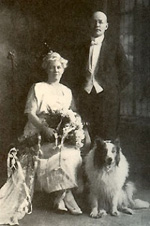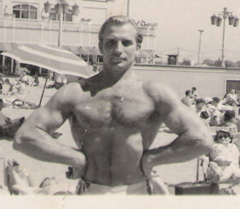Try Shock Therapy To Protect Against Vagabond Spirits?
Posted on 28 June 2011, 3:36
The annual conference of the Spirit Release Foundation (SRF) took place this past weekend (June 25-26) at the Royal Agricultural College in the beautiful Cotswold countryside of England. Founded in July 1999, the SRF is a professional organization dedicated to Spirit Release Therapy. At its website (www.spiritrelease.com), there is a list of therapists who may be able to help with cases of spirit attachment.
Such an organization no doubt draws many guffaws from mainstream medicine and probably involves some degree of professional suicide for those who dare believe that many of our mental health problems are a result of some form of spirit possession. Brazil probably has the most believers and healers in this area of belief. According to Dr. Emma Bragdon, a North American who has spent the last 10 years studying the Spiritist healing methods in Brazil, there are now 50 Spiritist psychiatric hospitals in that country, some of them dating back to the 1930s, using some form of spirit release therapy alongside conventional care. The Spiritist philosophy traces its origin back to Allan Kardec, a French educator and psychical researcher.
Apparently, there are many earthbound spirits floundering around in the vibrational vicinity of the earth plane looking for opportunities to attach themselves in some way to the auras of those of us still incarnate. In her 1999 book, Freeing Captives, the late Dr. Louise Ireland-Frey discussed various degrees of attachment, beginning with temptation and continuing on through shadowing, oppression, obsession, and possession.
Ireland-Frey, who earned her M.D. at Tulane University, said that it was not until late in her medical career, while studying hypnotherapy, that she came to recognize and understand spirit attachment.
One of the pioneers of spirit release therapy in the United States was Carl A. Wickland, M.D., a psychiatrist who specialized in cases of schizophrenia, paranoia, depression, addiction, manic-depression, criminal behavior and phobias of all kind. In his 1924 book, Thirty Years Among the Dead, which is now available from Whitecrow Books, Wickland stated that much of such mental illness is caused by intruding, or obsessing, spirits.
“Spirit obsession is a fact – a perversion of a natural law – and is amply demonstrable,” Wickland wrote. “This has been proven hundreds of times by causing the supposed insanity or aberration to be temporarily transferred from the victim to a psychic sensitive who is trained for the purpose, and by this method ascertain the cause of the psychosis to be an ignorant or mischievous spirit, whose identity may frequently be verified.”
Wickland’s wife, Anna, was a trance medium. (Carl & Anna Wickland below) Their method of combating the vagabond spirits attached to Wickland’s patients was to administer an electrical charge to the patient and drive the obsessing spirits from the patient to Mrs. Wickland. These obsessing spirits would then talk to Dr. Wickland using Anna Wickland’s body. Nearly all of them didn’t know they were “dead” and so Wickland explained their plight to them.
Mrs. Wickland was said to be protected from the vagabond spirits remaining with her by a group of strong intelligences known as “The Mercy Band.” As a representative of this Mercy band explained to Wickland, these earthbound entities become attracted to certain humans and attach themselves to the human aura, unwittingly conveying their thoughts to these individuals. It was further explained that the earthbound spirits could not be helped by spirits on their side until they recognized they were “dead.”

With one patient, Wickland related, he conversed with 21 different spirits through his wife. In all, they spoke six different languages even though Anna Wickland spoke only Swedish and English.
In Thirty Years, Wickland sets forth numerous cases of spirit release dislodgement, including the dialogue that went on between him and the vagabond spirits attached to his patients. As an example, with a patient identified only as “Miss R.F.” a spirit identified as Edward Sterling began speaking through Mrs. Wickland’s vocal cords. At first, he didn’t remember his last name and couldn’t remember what town he was from although he knew he was born in Iowa. When asked what year it was, Edward said it was 1901 (the year he had died). Wickland informed him that it was now 1920. Edward struggled to understand why his hair was now long and he had on women’s clothes. Wickland explained to him that he was now “dead” and occupying his wife’s body. “If I was dead I would go to the grave and stay there until the last day,” Edward responded. “You stay there until Gabriel blows the horn.”
At the end of a long conversation, Wickland seems to have convinced Sterling that his physical body had died, but that his spirit body was very much alive and that he should detach himself from Miss R.F. and let her get on with her own life. Wickland noted people take their beliefs with them when they die and that the false teachings of religion often keep them earthbound.
With a patient referrerd to as “Mrs. R.,” a spirit named Ralph Stevenson took over Mrs. Wickland’s body and began speaking to Dr. Wickland. Stevenson said he was “straggling along” when he saw a “light,” so he came in. However, he couldn’t figure out who he was or where he was. He thought it was 1902, when, in fact, it was 1919. When Wickland asked him how long he had been dead, Stevenson replied: “Dead, you say? Why I’m not dead; I wish I were.” Wickland asked him why he preferred to be dead and Stevenson said things had been very unpleasant for him. “If I am dead, then it is very hard to be dead,” he said. “I have tried and tried to die, but it seems every single time I come to life again. Why is it that I cannot die?”
Stevenson went on to say that he often thinks he is dead, but then he is alive again. “Sometimes I get in places (auras) but I am always pushed out in the dark again, and I go from place to place. I cannot find my home and I cannot die.” Wickland noted that Mrs. R., his patient, had often talked about killing herself. Further conversation with Stevenson revealed that he and a young woman named Alice were engaged to be married. However, when her parents objected to the marriage, he decided to kill Alice and himself. After killing Alice, he said he could not kill himself. In fact, he did succeed in killing himself after shooting Alice, but he assumed that he had failed and had been on the run ever since.
After Wickland convinced him that he, in fact, had succeeded in killing himself, Stevenson recognized his mother (in spirit). The mother then took over Mrs. Wickland’s body and explained that she had been trying to get through to her son for a long time, but he had built up a barrier that she could not penetrate until now. “He ran away from me whenever he saw me, and neither Alice nor I could come near him,” the mother communicated. “He thought he was alive and that he had not killed himself. Some time ago he came in contact with a sensitive person, a woman (Mrs. R), and has been obsessing her, but he thought he was in prison.”
Another of Wickland’s patients was a pharmacist with a drug addiction problem, especially addicted to morphine. After the patient was administered an electrical shock, the obsessing spirit jumped into Mrs. Wickland’s entranced body. Mrs. Wickland’s body then began violently coughing. Dr. Wickland asked what the problem was and the spirit replied that she was dying and needed some morphine. Wickland explained to her that she was already dead, but the spirit ignored his comments and continued to beg for morphine.
Wickland managed to calm her down enough to further explain the situation to her and ask her for a name. At first she couldn’t remember, but after several moments of searching gave her name as Elizabeth Noble. She said that she was 42 years old and was living in El Paso, Texas. After again begging for morphine, she noticed her husband, Frankie, standing there (in spirit). Frank Noble then took over Mrs. Wickland’s body and explained to Wickland that he had died before his wife and had been trying to get her to realize she had “passed out,” but had been unsuccessful. He thanked Wickland for explaining the situation to her and said that she would now understand and be better.
Dr. Wickland’s book reminded me of an experience concerning my father many years ago. Sometime around 1960, Dad bought an “electric shock box” at a second-hand store. He said they were very common during his younger years (early 1900s) and were “good for the nerves.” The box had two terminals with hand grips. After getting a good grip with each hand, you flipped a switch and got a continuous shock until the switch was turned off. Dad liked to challenge me, my brothers, and others to see who could take the electrical shock the longest. He would grit his teeth and take the shock for 15 or 20 seconds, his massive muscles twitching the whole time. Neither I nor the other challengers lasted more than a few seconds before yelling “Stop!” The possibility that the electrical shock was driving out obsessing spirits never really occurred to me and I don’t think it ever occurred to my father. (Egon Tymn below) In retrospect, however, it was about that time that my father changed from having a very volatile nature to a relatively mellow one. I always thought it was a result of aging, but now I am wondering if the shock box might have been responsible.

To my knowledge, the therapists practicing spirit release therapy today do not use electrical shock treatments, but perhaps they should. Maybe we should all keep an electric shock box around the house.
Thirty Years Among the Dead by Carl Wickland, M.D. is available on White Crow Books.
Michael Tymn is the author of The Afterlife Revealed: What Happens After We Die, Resurrecting Leonora Piper: How Science Discovered the Afterlife and Dead Men Talking: Afterlife Communication from World War I.
Read comments or post one of your own
|